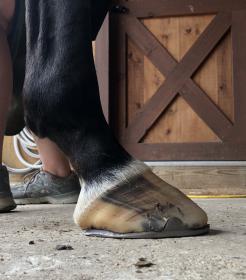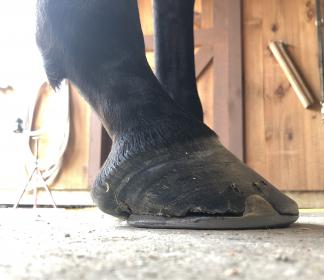I do not know nearly as much as several people on this thread, but it is amazing what an education you get when your own horse has an issue that needs solving. :yes:
For irrational reasons I’m compelled to throw out this one thought, after first putting up a steel umbrella in case of brickbats being thrown. :winkgrin:
OP, if you do go barefoot with one or more feet, and if you feel reasonably comfortable that you know what the hoof shape should be, get a rasp and maintain the shape yourself, while the horse is barefoot. The idea is to keep the foot shaped on a continuous basis, rather than waiting X many weeks between farrier visits. Instead of this endless farrier cycle of the foot growing out and losing shape, and then the farrier comes and brings it in again, fighting the same re-direction over and over, you can make little ongoing corrections on a frequent basis to keep the foot shaped and maintain the direction of growth. That will also help keep the white line where it belongs.
IMO anyone who can file and shape their own fingernails can do some ongoing rasp maintenance of a hoof [dodges flying brickbat thrown by farrier]. At some point you’ll want the farrier to come again, but hopefully the farrier will then be getting something good to work with.
My horse was always growing out the white line along with his toes, making it harder to shape the toes, just as has been described above. While he was barefoot I was determined to keep it all together with a rasp.
I wish I could send you the farrier who saved my horse’s feet. The feet were bad enough on softness and shape, and so hard to manage for progress, that there was even some question if they might be jeopardizing the horse’s useful life. Classic case of a foot that had difficulty holding a nail, and even more difficulty holding the next set of nails after the next shoeing. And had to have shoes to defend the shape. This farrier was an original out-of-the-box thinker and was vastly experienced with, shall we say, unorthodox techniques. He brought those feet back from disaster, even though it took quite a while for nutrition and health improvements to catch it all up to consistency.
Not sure your horse needs this link https://formahoof.com/ (his feet don’t look like an emergency to me), but I wish it had been available when my horse could have used it. It’s more for horses that are missing large hoof chunks, severe founder, and/or have other dastardly problems, and this may be the last chance. But for those who can afford it, used properly, this product will put a foot on a horse. And horses can perform, even race, while wearing it. Just for the interest.


 I was excited yesterday because two different people independently recommended the same farrier, but I went to one barn to check out his work and wasn’t impressed. The easy horses looked fine but the LTLH one (whose feet I happen to be familiar with) was super short-shod and the heels looked horrible, maybe even worse than my horse. The farrier has only done that horse twice but I can’t see any improvements happening with the way it’s set up. Very disappointing. I do have a call into someone else so we’ll see.
I was excited yesterday because two different people independently recommended the same farrier, but I went to one barn to check out his work and wasn’t impressed. The easy horses looked fine but the LTLH one (whose feet I happen to be familiar with) was super short-shod and the heels looked horrible, maybe even worse than my horse. The farrier has only done that horse twice but I can’t see any improvements happening with the way it’s set up. Very disappointing. I do have a call into someone else so we’ll see.

